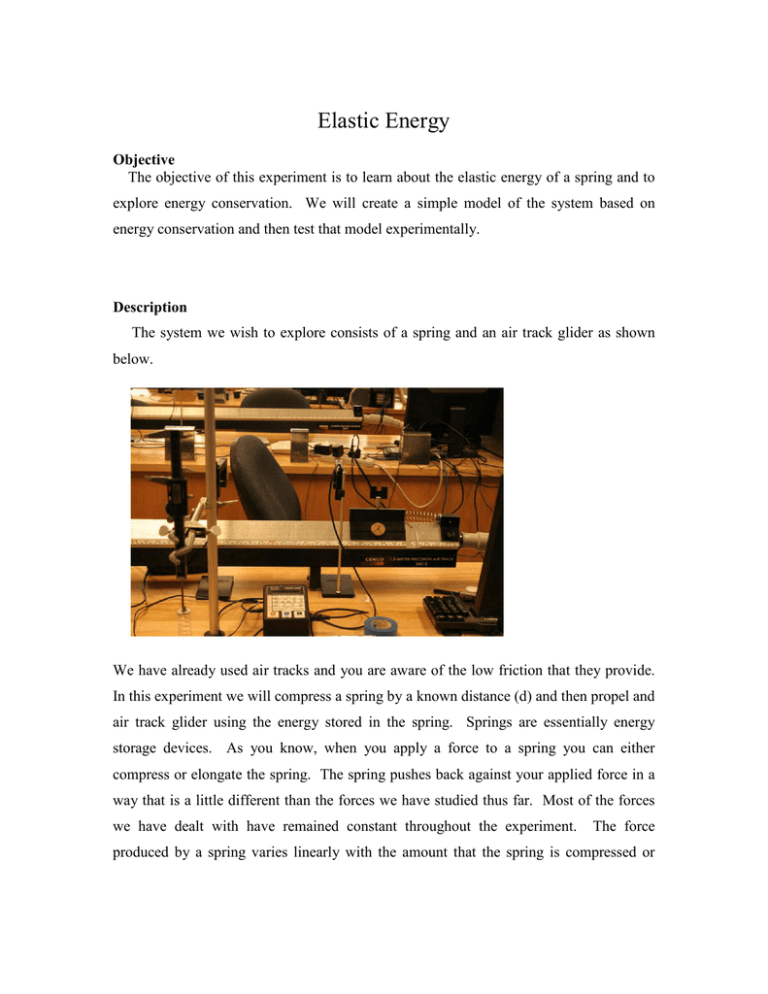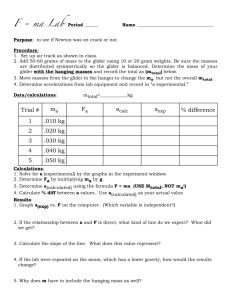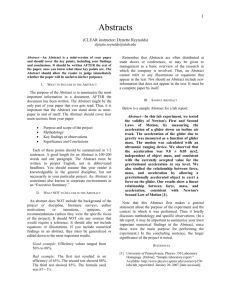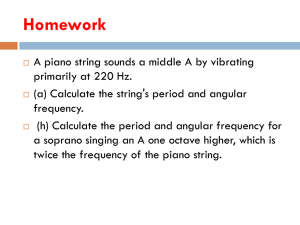Elastic Energy
advertisement

Elastic Energy Objective The objective of this experiment is to learn about the elastic energy of a spring and to explore energy conservation. We will create a simple model of the system based on energy conservation and then test that model experimentally. Description The system we wish to explore consists of a spring and an air track glider as shown below. We have already used air tracks and you are aware of the low friction that they provide. In this experiment we will compress a spring by a known distance (d) and then propel and air track glider using the energy stored in the spring. Springs are essentially energy storage devices. As you know, when you apply a force to a spring you can either compress or elongate the spring. The spring pushes back against your applied force in a way that is a little different than the forces we have studied thus far. Most of the forces we have dealt with have remained constant throughout the experiment. The force produced by a spring varies linearly with the amount that the spring is compressed or extended. That is an ideal spring, real springs, however exhibit nonlinear behavior. The ideal spring obeys the following relation, Fs=-kx. [1] This is known as Hooke’s law and it usually applies only over a limited range of displacements. Keep in mind that this is the force produced by the spring. The negative sign tells us that if we stretch the spring, the spring produces a force that wants to pull the spring back to its initial unstretched length. When you release the spring it “springs” back to its original length. The spring constant “k” in this equation tells us about the stiffness of the spring. It relates to force we have to apply to the amount of stretch or compression we get. Some springs are squishy and some are stiff. The stiffer a spring is the larger the value of the spring constant. If you make a graph of the Force applied to a spring as a function of the displacement, you should obtain a straight line. The slope of the line gives the spring constant. The graph shown below illustrates the force relationship for a spring from one of our projectile launchers. The spring constant is the slope, so we have k=1.32x102 N/m. Projectile Launcher Spring 1.40E+00 y = 131.75x - 0.0451 R2 = 0.9989 1.20E+00 Applied Force (N) 1.00E+00 8.00E-01 6.00E-01 4.00E-01 2.00E-01 0.00E+00 0.00E+00 2.00E-03 4.00E-03 6.00E-03 8.00E-03 Compression Distance (m) 1.00E-02 1.20E-02 Springs are energy storage devices. When you change the length of a spring, you do work against the spring force. For a spring, the amount of work you do is not linear with the change in length. That is because the force you have to apply depends on the change in length. To calculate the work done you must take into account the fact that the force changes. You can find the work done in compressing the projectile launcher spring by finding the area under the force-displacement curve or by using calculus. In either case we have the result that the work done is proportional to the square if the displacement. The work you do in compressing the spring is stored as elastic potential energy. When you release the spring, it can do work on another object. In this experiment the spring will do work on the air track glider. The work done by the spring force is given by, Ws = 1 2 1 2 kxi − kx f . 2 2 [2] When you compress the spring a distance x from its initial equilibrium position, you store W= 1 2 kx worth of energy in the spring. 2 This energy can be used to increase the kinetic energy of the glider. In our case, the glider starts from rest and has no initial kinetic energy. If we assume that all the energy stored in the spring is completely transformed into kinetic energy of the glider, then we can solve for the velocity of the glider when it breaks contact with the spring. Energy conservation allows us to write, 1 2 1 2 kx = mv 2 2 [3] where v is the speed of the glider when it leaves the spring. In reality not all of the elastic potential energy goes into the kinetic energy of the glider. There is internal friction within the spring and you can see that the spring has a little vibration when the glider flies off. We can then solve for the velocity of the glider and obtain, v= k x . m [4] Procedure In order to determine the spring constant, we must measure the force-displacement relationship. This will require the use of a Vernier caliper and an electronic balance. Setup the caliper and balance as shown below. Notice that the end of the caliper has been modified to enable it to compress the spring. Mount the caliper in the three finger clamp as shown. Zero the electronic balance without the caliper contacting the spring Then move the jaws apart until the screw makes contact with the washer as shown above. You can determine when contact is made by watching the electronic balance. As soon as you see a small nonzero weight indicated, you have made contact with the spring. Once the caliper has made contact with the washer, re-zero the caliper. This is the initial position. Extend the caliper so that it compresses the spring a fraction of a millimeter. Record the weight shown on the balance. This weight is an indication of the normal force applied by the scale. Since it reads in mass units, you must convert the reading to force by multiplying by the acceleration due to gravity. Continue extending the caliper until you have reached about 1.5cm. If you go too far, the spring will pop out from under the washer. Plot the force as a function of displacement and determine the spring constant from the slope. From the linear portion of the curve determine the maximum allowable displacement so that the force function is still linear. Now that you have determined the spring constant, you are ready to measure the velocity of the glider. The spring is mounted horizontally onto the air track as shown below. A socket wrench is used to attach the spring to the air track. Use a flat washer to hold the spring in place. Adjust the spring so that it does not rub against the track when released. The final setup is shown below. When you pull the glider back you have to measure the amount that the spring is compressed. You can use a straight edge or a weight hanger as a guide to measure the position of the edge of the glider. Place a photogate timer close to the glider so that its velocity is measured shortly after it breaks contact with the spring. Record the spring compression length and the velocity of the glider. Remember to correct the velocity by multiplying by a factor of 2.5. Plot a graph of glider speed squared (V2) as a function of spring compression squared (x2) Find the slope of this graph and compare to the ratio of the spring constant to the mass (k/m). Give the percent difference. Additional Procedure if time Permits We have also studied gravitational potential energy. In the first set of experiments the air track was level with the table. If we slightly incline the air track the spring must do work against gravity. This reduces the speed the glider has when it breaks free from the spring. As the glider travels along the track it changes elevation which slows the glider down. The energy stored in the spring must b transformed into the kinetic energy of the glider and enable the glider to do work against gravity as it moves uphill. Derive an equation that relates the velocity of the glider to the distance along the track as measured from the release point. Use this equation to predict the velocity at some position along the track and verify the prediction by experiment. When determining the angle of the track, you can use the angle indicators to get a rough idea of the angle. For calculation purposes, measure the actual slope of the track and determine the angle. Compress the spring by an amount you have already used in the first experiment. Use a photogate to determine the launch speed of the glider and verify that it is less than in the flat track case. Use a second photogate to measure the speed at some distance up the incline. Compare this to you theoretical result and also report the percent difference.




